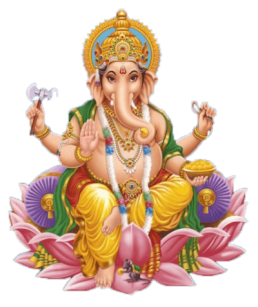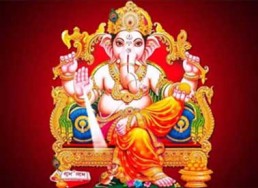Gananamtva Ganapatim
कविं कवीनामुपमश्रवस्तमम् ।
ज्येष्ठराजं ब्रह्मणां ब्रह्मणस्पत
आ नः शृण्वन्नूतिभिः सीद सादनम् ॥
kaviṃ kavīnāmupamaśravastamam |
jyeṣṭharājaṃ brahmaṇāṃ brahmaṇaspata
ā naḥ śṛṇvannūtibhiḥ sīda sādanam ||
You are the wisest among the scholars. Your wisdom is known to be highest quality and incomparable for its glory.
You are the eldest or foremost of the kings (referring to devas), the Lord of the sacred prayers, rituals and its performers.
O Lord, come to us by hearing our hymns and be seated in this sacred sacrificial altar.

Description
This sacred mantra is usually chanted at the beginning of all Vedic chants. This mantra of Rig Veda 2.23.1 is addressed to Brihaspati/Brahmanaspati, and refers to Ganapati. This is a very powerful chant dedicated to Lord Ganesha, the remover of all obstacles. Ganesha or Ganapathi, undoubtedly, is the most popular among the Hindu gods. His popularity and worship extends to Buddhism and Jainism. He is worshiped not merely in India but in other parts of the world too. He is an ancient God. The earliest reference to Ganapathi appears in the second book of the Rig Veda in the rik starting with the above verse Ganaanaam tva Ganapati Gum Havamahe (RV 2.23.1).
Ganapati means “leader of the people” (gana-“Host, group of people”, pati-“father, Lord”), i.e. Chief of the Ganas. It is explained that Ganapathi in this rik refers to Brahmanaspati, a Vedic divinity of the highest order, the leader of the heavenly bands and a sage (kavi) among sages (Jyeshta Rajam Brahmanam, Brahmanaspata).
Ganesha is another name for Ganapati – Gana-Esha, again referring to a Lord (Isha) of the Hostthe remover of all obstacles.
Ganaanaam of Ganas. GaNa refers to a group or collection of people
tvaa you
gaNa-patim pati means Lord. So, Lord of the ganas.
havaamahe aahvaamahe Hava means an oblation. Havaamahe means’ we offer our oblations.
kavim poet (inspirer)
kaviinaam of the poets
upama comparable. In this context, it means incomparable
shravaha that which is famously heard as, glory
tamam of the highest quality
Oh Lord of all people, we offer our oblations! The inspirer of poets, famously heard of as incomparable and the highest Glory – Supreme
jyeshhTha eldest
raajam raaj means to shine. Devata also means one who shines. Raj here refers to devatas
bramhaNaam that which is related to bramhan (absolute consciousness)
bramhaNaha vedas and those who recite them.
pate comes from patihi which means ‘lord’
aa = come near!
naha = us
shRuNvann = hearing
uutibhihi = out of your grace
siida = sit
saadanam dwelling
Senior-most among the devatas, the Lord of the Vedas and the chanters. Hear us, grace us and be present in the seat of this altar.
Other Ganesha Shlokams
Agajanana Padmakam
We meditate day and night on the one-tusked one who is the sun for the lotus in the form of the face of Pārvatī, the one with the elephant face and the one who is the giver of all desired ends to his
Gajananam Bhuta
I bow to you, the Lord with the face of an elephant (Gajanana), one who is served by the celestial attendants (Bhoota ganas) and other beings. The one who consumes the extract of Kapitha (wood apple)
Ganapathi Atharvashirsha
The Ganapati Atharvasirsha Upanishad is a Sanskrit text and a minor Upanishad of Hinduism. It is a late Upanishadic text dedicated to Ganesha, the deity representing intellect.
Ganapati Stotram
As the rays from the lotus-face of Gauri (Devi Parvati) is always on her beloved son Gajanana (Who has the face of an Elephant), Similarly, the grace of Sri Ganesha is always on his devotees; Granting
Ganesh Chathurthi
Significance of Ganesh Puja, Vinayaka Chavithi or Chathurthi. See how to prepare for Ganesha Pooja, How to perform the Puja with Video instructions and enjoy Audio devotional songs, uninterrupted and without ads.
Ganesha Gayatri Mantra
We pray to the one-tusked; we meditate on the one having a twisted trunk. May that Ganapati (one-tusked) inspire us (to meditate).
Ganesha Pancharathnam
The composer, Guru Sri Adi Shankaracharya had praised the God Ganesha by presenting these five stanzas as five jewels, hence the name Maha Ganesha Pancharatnam.
Ganesha Stavah
Ganesha Stavah or Ganapati Stavah is a set of 13 verses that describe the glory of Lord Ganesha. Gaṇapati stavaḥ is said to be from Ganesh Purana - upāsanā khaṇḍa adhyāya 13.
Mooshika Vahana
Salutations to Sri Vighna Vinayaka, whose vehicle is the mouse and who has the modaka in his hand, whose large ears are like fans and who wears a long sacred thread, who is short in stature and is th
Sankata Nashana Ganesha Stotram
This stotram is from Narada Purana. Sankata means problems, difficulties and Nashanam means to destroy. So, by chanting this stotram one is praying to Lord Ganesha to remove his difficulties. In Sanskrit, English Translation, Meaning, Significance…
Shuklambaradharam
I meditate upon (Lord Ganesa), the one who wears a white garment, who is all-pervasive, who has a (bright) complexion like the moon, who has four hands, who has a cheerful face, for the removal of all
Vakratunda Mahakaya
O god with the twisted trunk, broad-bodied, brilliant as thousand suns, bless me with freedom from obstructions and hindrances in all my works and for all times.
Gananamtva Ganapatim – Ganesha – In Sanskrit, English Translation, Meaning, Significance and Audio.


